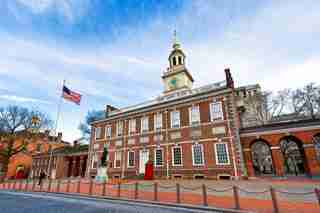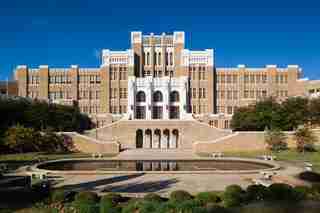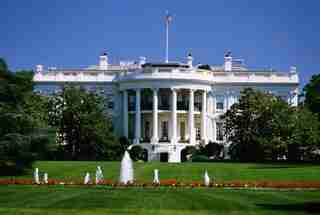As backdrops of important historical events, these buildings are now inextricably woven together with what transpired there, whether a battle or the brokering of peace. Some symbolize the formation of a government and others the remnants of colonialism. But each of them has changed the course of America’s fascinating history. And yet, built within various locations and eras, each of these buildings reflects a different architectural theme, including neoclassical and Art Deco. Thankfully, through government organizations such as the National Historic Landmarks Program (NHLs), these structures have been restored and preserved for the benefit of future generations. AD surveys seven structures that bore witness to some of America’s most dramatic events.

It can be argued that Independence Hall is the most important building in the founding of the United States of America. Completed in 1756, and originally used as the Pennsylvania State House, it was outfitted in red brick by Edmund Woolley in a Georgian-style architecture. The building was the site of the signing of the Declaration of Independence (1776), the ratification of the Articles of Confederation (1781), and the development of the U.S. Constitution during the Constitutional Convention (1787).

All eyes were on Little Rock, Arkansas, when, in 1957, nine African-American students volunteered to begin integration of the school at Central High School . Known as the Little Rock Nine, the students instantly became the symbol of school integration in America. Built in 1927, Central High School was designed by architects John Parks Almand, Lawson Delony, George R. Mann, Eugene John Stern, and George H. Wittenberg, in a combination of Collegiate Gothic and Art Deco styles, complete with four Greek goddess statues over the front entrance of the school.

With its symmetrical Palladian-style design, the White House was constructed in 1792 by Irish architect James Hoban. The building that housed the president of the United States went through several renovations over the years, including porticos added by B. H. Latrobe in 1807-8, and the Oval Office, added in 1909. Nearly all of the most significant political agendas in American history have, at one point, been discussed, debated, and signed into law within the White House.
The Wilmer McLean House was the site of Confederate General Robert E. Lee’s surrender to the leader of the Union Army, General Ulysses S. Grant. The event, which took place on April 9, 1865, was the monumental moment that ended the Civil War. After the conflict, the McLean House was sold and repurchased several times. Finally, it was dismantled to be relocated elsewhere but was never moved. The building was then reconstructed in the 1940s. Originally built by Charles Raine in 1848, the McLean House’s style and construction were typical of the period and location, as a county seat and a farming community in Virginia in the mid-19th century.
The Chapel at the Alamo Mission in San Antonio, Texas, was the site of a 13-day siege in which a vastly outnumbered group of volunteer Texan soldiers unsuccessfully attempted holding off the Mexican army in 1836. Former congressman Davy Crockett, from Tennessee, was among the men killed. “Remember the Alamo!” became a rallying cry during subsequent battles as Texas fought for its independence. Originally built in 1744, the rounded “hump” to hide the mission’s first-ever roof was added by architect John M. Fries in the mid-1800s.
Completed in 1922, Washington, D.C.’s Lincoln Memorial was built in the style of the ancient Greek temple, the Parthenon. Rising 30 feet off the memorial floor is a marble statue of Abraham Lincoln, a keystone that architect Henry Bacon thought would be appropriate for a president who defended democracy. Since then, it has been an attraction for students and tourists, and a site for civil rights demonstrations and events. In 1963, Dr. Martin Luther King Jr. gave his “I Have a Dream” speech from the steps of the memorial before a crowd of thousands.
Once home to the monarchy of the Kingdom of Hawaii, the Iolani Palace is the only royal court in the U.S. After several coups, Hawaii was eventually colonized by the U.S. The volcanic archipelago became a territory in 1900 and our 50th state in 1959. Designed by San Francisco architect Thomas J. Baker, the building contains both European and Hawaiian features. Most striking are the palace’s six towers built in the European Renaissance architectural style. Finished in 1882, the building is now a museum.
